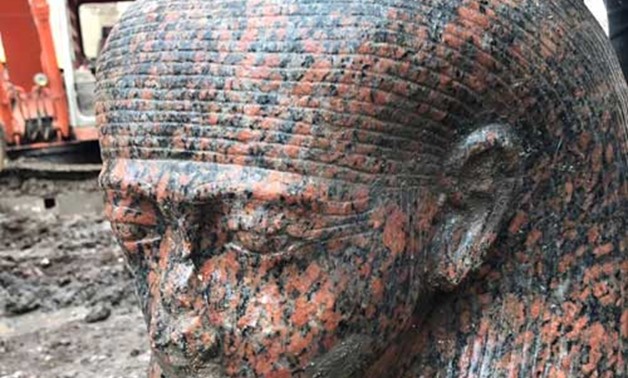
File-A unique royal bust of King Ramses II made of red granite.
CAIRO – 13 December 2019: A unique royal bust of King Ramses II made of red granite was unearthed on a private land in Mit Rahina village in Giza by an Egyptian archaeological mission from the Ministry of Antiquities on Wednesday, December 11.

The newly discovered bust is emblazoned with the “Ka,” a symbol of power, life force and spirit.
King Ramses II bust is carved in red granite and depicts Ramses II wearing a wig with the symbol of the “Ka” over his head. The bust is 105 cm tall, 55 cm wide and 45 cm thick.
The mission discovered this unique bust during excavations on privately owned land in Giza, after the landowner was caught carrying out illegal excavation work at his land.
Mostafa Waziri, secretary-general of the Supreme Council of Antiquities, announced that the uncovered King Ramses II bust is one of a kind because the only similar bust is one carved in wood and belongs to 13th Dynasty King Hor Awibre, which is now on display at the Egyptian Museum in Cairo.
The mission has also discovered a group of huge red granite and limestone blocks engraved with scenes showing Ramses II during the Heb-Sed religious ritual, which indicates that these blocks could belong to a great temple dedicated to the worship of the deity Ptah.
The bust and the blocks have been transferred to Mit Rahina open air museum for restoration, and excavations will continue at the site.
One of the main achievements of King Ramses II is building Abu Simbel temple to impress Egypt's southern neighbors, and also to reinforce the status of the Egyptian religion in the area.
Abu Simbel was one of six rock temples erected in Nubia during the ruling period of Ramses II and its construction took 20 years from 1264 BC to 1244 BC.
Abu Simbel is made up of two temples. The smaller one was built for Queen Nefertari and has two statues of her and four pharaohs; each about 33 feet (10 meters) in height.
According to many scholars, this great temple was created to celebrate the victory of Ramses II over the Hittites at the Battle of Qadesh in 1274 BC. This means that the temple was situated on the border of the conquered lands of Nubia after many military campaigns were carried out by the Pharaoh against Nubia.



Comments
Leave a Comment